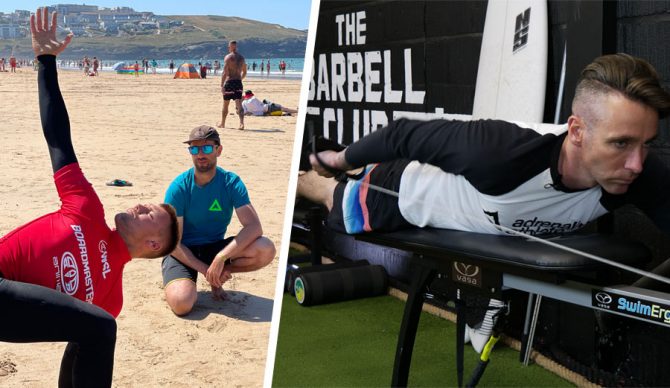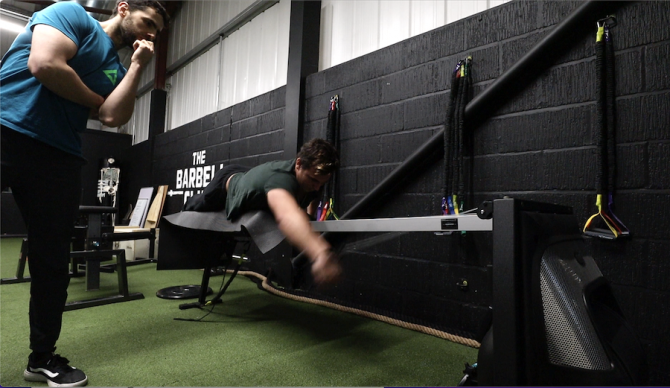
Want to improve your paddle fitness? Here’s where to start. Photo: Adrenaline Athlete.
Editor’s Note: This piece was written and supported by Alan Bisseker of Adrenaline Athlete, a professional strength and conditioning coach who works with elite athletes across multiple sports, including world champions, Olympic gold medalists, and many pro surfers. Get 30 percent off Alan’s monthly membership program, with weekly workouts delivered straight to your phone, here. If you’re interested in working with Alan 1-on-1, he is offering a free 45-minute Zoom consultation. Sign up now.
If you take nothing else away from reading this article, please let it be this. When it comes to improving physical performance in surfing, keep it simple, focus on what exactly it is you’re trying to improve, and meet yourself where you’re at.
What prevents most people from making headway in land-based surf training is the tidal wave of nonsense you’ll find on social media (excluding this account, of course). Once you cut through the noise, surf training is not complicated. I should also point out that I’m not here to overplay the importance of strength and conditioning in surfing, because ultimately, technical ability will be the biggest factor in how you perform in the water. Strength and conditioning (if used correctly) will just allow you to perform faster, harder, and for longer – and who doesn’t want that!
With that in mind, I decided to break things down into simple exercises anyone can do, focused on improving specific aspects of surfing such as paddling, popping up, and wave-riding that are crucial for any surfer from beginner to pro. The exercises I have provided are by no means exhaustive, but they will work for 99 percent of you. This, the first of three articles, will focus on paddle fitness.

QS surfer and English National Champion Luke Dillon tests his paddle power. Photo: Adrenaline Athlete.
For many surfers, especially newbies, “paddle fitness” is the single-largest barrier to progression. We spend up to 55 percent of our time in the water paddling, at varying intensities and with limited rest, especially when making our way out the back. Therefore, you need sufficient aerobic capacity (or VO2max) to sustain repeated, intense paddling efforts, quickly replenish energy, and then go again, many times over.
At a muscular level, you also need excellent endurance of your glutes, abs, lats, traps, upper back and shoulders (to name a few) to hold you in that extended “arched” position and perform the repetitive paddling motion, without the dreaded “shoulder burn” stopping you in your tracks.
How to Train
Aerobic capacity: Any steady state, low intensity activity such as swimming, cycling, or running will help to put in the necessary infrastructure (tiny blood vessels, oxidative cells, ventricular capacity, etc.) required to increase your aerobic capacity. 30 to 90 minutes at a steady pace, three times per week will deliver results.
For the time-crunched surfer, shorter, higher intensity intervals have also proven effective in improving aerobic capacity. Try six to eight minutes of hard (but sustained) efforts on a rowing machine or SkiErg (with matching rest periods), or 20 to 30 second all out efforts with 40 seconds of rest to improve paddle fitness.
Muscular endurance: Embrace the shoulder burn! The dreaded Bottle Hops exercise (see above) is both loved and hated by my private clients, but you will struggle to find a more powerful stimulus for burn-resistant shoulders. Try timed sets of 30 to 60 seconds of quality reps (similar rest periods, initially) or aim to complete 100 total quality reps, with as few rests as possible.
Next up in this series: sprint paddling and popping up.
Learn more at AdrenalineAthlete.com.

